

Rock Art. Indigenous Art. Aboriginal art always tells a fascinating story.
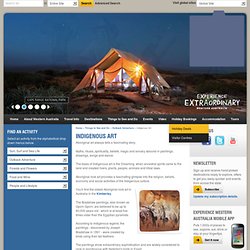
Myths, rituals, spirituality, beliefs, magic and sorcery abound in paintings, drawings, songs and dance. The basis of Indigenous art is the Dreaming, when ancestral spirits came to the land and created rivers, plants, people, animals and tribal laws. Aboriginal rock art provides a fascinating glimpse into the religion, beliefs, economy and social activities of the Indigenous culture. You'll find the oldest Aboriginal rock art in Australia in the Kimberley. The Bradshaw paintings, also known as Gyorn Gyorn, are believed to be up to 60,000 years old - which is at least five times older than the Egyptian pyramids. According to Indigenous legend, the paintings - discovered by Joseph Bradshaw in 1891 - were created by birds using their tail feathers. The paintings show extraordinary sophistication and are widely considered to rank in significance with Nefertari's tomb in Egypt. Arts Experience. Australian Indigenous art. Bark Painting, Evans Collection, Northern Territory Library.
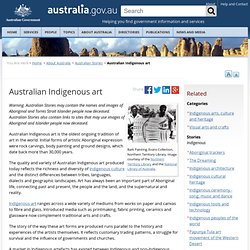
Image courtesy of the and the . Warning. Australian Stories may contain the names and images of Aboriginal and Torres Strait Islander people now deceased. Australian Stories also contain links to sites that may use images of Aboriginal and Islander people now deceased. Aboriginal rock art. Aboriginal rock art facts Australian Aboriginal rock art is world famous.

Some of the oldest and largest open-air rock art sites in the world include the Burrup Peninsula and the Woodstock Abydos Reserve, both in Western Australia. Engravings found in the Olary region of South Australia are confirmed to be more than 35,000 years old [5], the oldest dated rock art on earth. Researchers assume that there are more than 100,000 significant rock art sites in Australia [5] and 5,000 in the Northern Territory’s Kakadu National Park. But there is no central register of Australian sites, and some spectacular places are known only to two or three people [5]. Rock art paintings found in the Djulirri rock shelter in north-west Arnhem Land chronicle Aboriginal contact with Maccassan traders from Sulawesi, believed to be the first visits to Aboriginal people from outside Australia. Some archaeologists call rock art “rock documents” or “a third archive”, besides oral history and written documents [13]. Aboriginal Art Store Art History & Culture: Aboriginal Symbols Glossary Archives.
Many of the symbols used by Aboriginal artists are a variation of lines or dots.
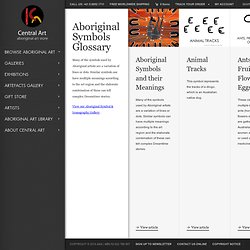
Similar symbols can have multiple meanings according to the art region and the elaborate combination of these can tell complex Dreamtime stories. View our Aboriginal Symbol & Iconography Gallery. Aboriginal Symbols and their Meanings View article Animal Tracks This symbol represents the tracks of a dingo, which is an Australian native dog. Percy Trezise: One man's passion for Quinkan Rock Art helps preserve Aboriginal cultural history. Updated Interactive: Find out what's depicted in the Quinkan rock art.
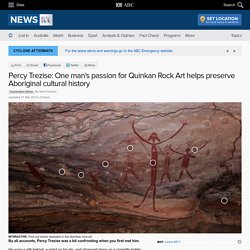
By all accounts, Percy Trezise was a bit confronting when you first met him. He wore a pith helmet, a pistol on his hip, and chomped down on a cigarette holder. He moved quickly through the Cape York Peninsula scrub and was often accompanied by his bush mates, including his adventure partner, Aboriginal artist Dick Roughsey. But Percy wasn't just a man's man.
Today Percy's sons Matt and Steven are still tramping through the bush under the spell of an obsession which has made the Trezise name synonymous with the oldest art in the world - the legendary Quinkan Rock Art. It is an obsession that has occupied the lives of two generations of Trezise men, but which has come at a cost to relationships. Cultural history preserved in pristine wilderness The Quinkans are situated in pristine wilderness near Laura, a small town four hours north-west of Cairns. There they cooked, slept and painted. "Dad was indefatigable. Burrup Peninsula rock art among world's oldest. RESEARCH INTO THE rate of erosion of Pilbara rocks has put an upper limit on the possible age of up to a million ancient Aboriginal engravings in the Burrup Peninsula of Western Australia.
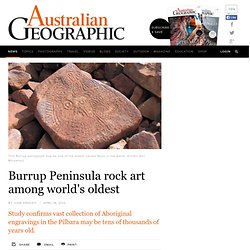
The peninsula and surrounding Dampier Archipelago have the highest concentration of rock art in the world. The carvings, called petroglyphs, include depictions of human-like figures, human faces and animals that no longer inhabited the region, including the Tasmanian tiger. Archaeologists haven't been able to date engravings directly, but have previously estimated some of them to be up to 30,000 years old based on the style of the art and weathering patterns. One group of petroglyphs showing land-based animals, is thought to date from a time during the last ice age, when sea levels were lower and the area was far inland.
Low rates of erosion Cosmic radiation used to date rocks Brad and his co-author Professor L. The Bradshaw Paintings - Australian Rock Art Archive. Wandjina Art from the Kimberley - Aboriginal Art Online. Wandjina figures are some of the most visually striking of all images in Kimberley art.
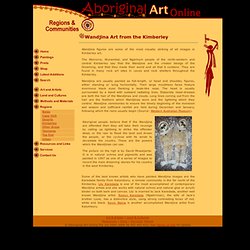
The Worrorra, Wunambal, and Ngarinyin people of the north-western and central Kimberley say that the Wandjina are the creator beings of the Dreaming, and that they made their world and all that it contains. They are found in many rock art sites in caves and rock shelters throughout the Kimberley. Wandjina are usually painted as full-length, or head and shoulder, figures, either standing or lying horizontally. Their large mouthless faces feature enormous black eyes flanking a beak-like nose. The head is usually surrounded by a band with outward radiating lines.
Ancient Ochres by Roberts. Rock Paintings of Aboriginal Australia by Roberts 1. Rock Paintings of Aboriginal Australia by Godden 2. "rock art" "western australia" Burrup peninsula rock art map. Bradshaw paintings. ThingLink blank. Ancient Stories by Mrs Roberts.